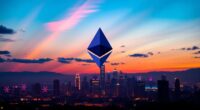GPU mining is the process where you use high-end graphics processing units to validate transactions on a blockchain and earn cryptocurrency. It involves solving complex cryptographic puzzles through a method called Proof of Work. You'll need a solid setup, including a powerful GPU, a motherboard that supports multiple GPUs, and sufficient RAM. While it's more affordable than ASIC mining, GPU mining isn't as efficient, with higher energy consumption affecting profits. If you want to optimize your mining operation and understand the nuances of GPU mining better, stick around to explore the important details and best practices.
Key Takeaways
- GPU mining involves using high-end graphics cards to validate blockchain transactions through solving complex cryptographic puzzles via Proof of Work (PoW).
- It allows miners to earn cryptocurrency rewards while contributing to network security and transaction verification.
- Unlike ASIC miners, GPU mining is more versatile, enabling mining of various cryptocurrencies and offering customization options like overclocking.
- Power consumption and efficiency are critical factors, as they significantly impact mining profitability and operational costs.
- Proper setup and maintenance, including cooling systems and energy-efficient components, enhance the performance and longevity of mining rigs.
GPU Mining Fundamentals
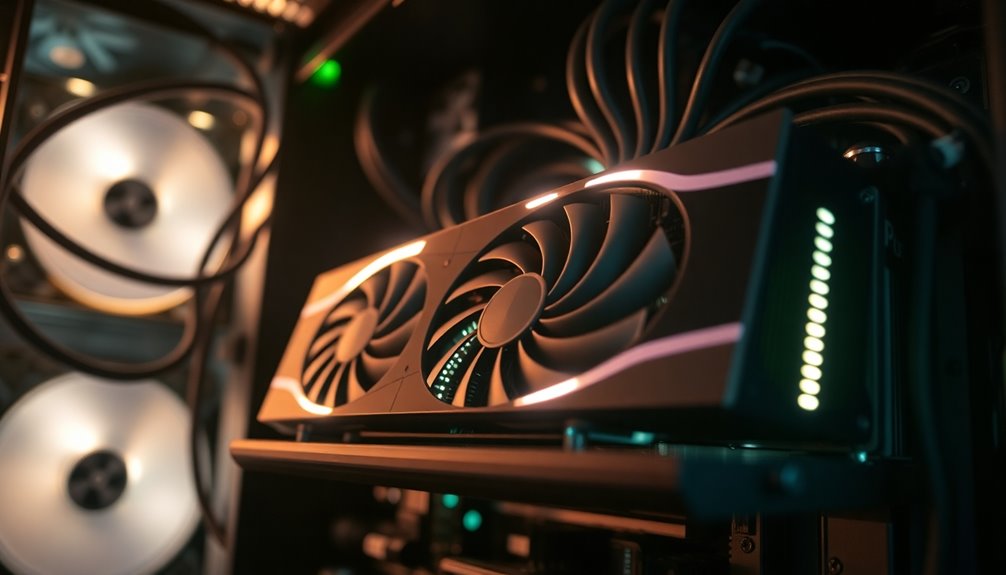
When you're diving into GPU mining, understanding the essential hardware and software requirements is crucial for success.
You'll need high-end GPUs, specifically from Nvidia or AMD, known for their high hash rates. Pairing these with a motherboard like the ASRock H81 Pro BTC allows you to support multiple GPUs. Mining is an intensive process that can increase computer temperature due to the high demands placed on your hardware.
A low-end CPU, around the Intel 8th or 9th generation, suffices since the GPUs do the heavy lifting. Don't forget 4GB to 6GB of DDR4 RAM, and a robust power supply to meet the demands of your setup.
For software, consider options like CGMiner or Hive OS, and ensure you have a reliable internet connection.
Lastly, a crypto wallet is necessary to store your mined coins securely.
Mining With Graphics Processors
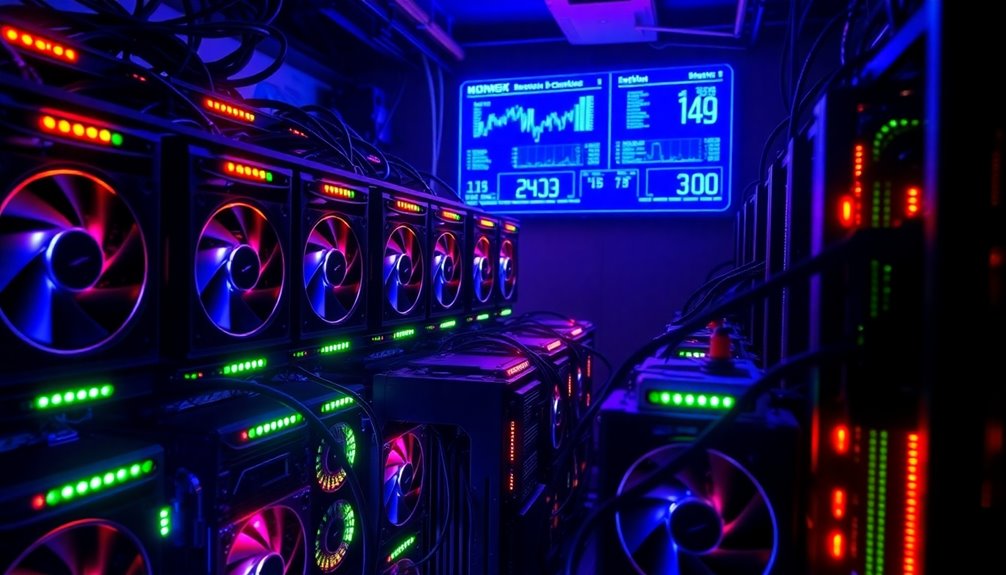
Mining with graphics processors can be an exciting venture, especially when you grasp the intricacies of how these powerful components work together.
To start, you'll need robust GPUs from NVIDIA or AMD, a compatible motherboard for multiple GPUs, and a high-capacity power supply unit—ideally a 1200w platinum-rated PSU.
Don't forget about RAM; 4GB to 6GB of DDR4 is enough for a basic setup, along with a small SSD to house your operating system and mining software.
Choose mining software like CGMiner or Ethminer, and ensure you have a stable internet connection. Additionally, the transition to GPU mining has become essential due to the increased competition and efficiency it offers over CPU mining.
Joining a mining pool enhances efficiency, allowing you to combine resources and share rewards.
Finally, managing electricity and cooling is crucial for optimal performance.
Mining Process Explained Simply

Understanding the mining process can seem daunting, but it's essentially about validating transactions on the blockchain. Miners, like you, use GPUs to tackle complex cryptographic puzzles through a method known as Proof of Work (PoW). Your GPUs perform hashing functions, mapping varying data sizes to fixed-size hashes, ensuring security. Additionally, it's important to consider that power consumption plays a significant role in the overall profitability of your mining operation.
You'll calculate block headers to generate a seed for mining, integrating network data and cache memory to verify transactions. To boost efficiency, you might run multiple GPUs, leveraging their cores for arithmetic operations. Mining software connects you to the blockchain, while a stable internet connection is vital. A crypto wallet is necessary to store your mined coins, and proper cooling systems help manage the heat generated during this process.
Pros and Cons
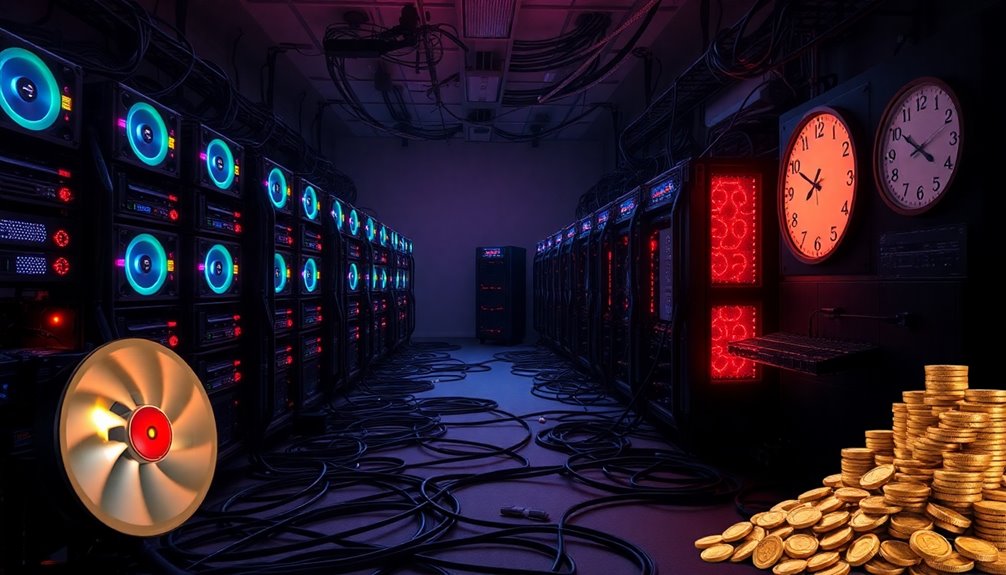
GPU mining offers a mix of advantages and drawbacks that can significantly impact your experience and success in the field.
On the plus side, its versatility allows you to mine various cryptocurrencies, adapting easily to market shifts. Customizability in settings like overclocking can enhance performance. Plus, it's generally more affordable than ASIC miners, making it accessible for newcomers. This flexibility to adapt is particularly valuable as mining rewards and transaction fees can fluctuate with market conditions.
However, you'll face challenges; GPU mining has lower efficiency and hash rates compared to ASICs, which can affect your return on investment. Additionally, energy consumption is higher, increasing operational costs and environmental concerns.
The complexity of setup and potential for obsolescence also pose risks, as GPUs may become ineffective as mining difficulties rise.
GPU vs. CPU Mining

When choosing between GPU and CPU mining, the differences in performance and efficiency can greatly influence your decision.
GPUs outperform CPUs significantly, boasting higher hash rates and faster processing speeds. With thousands of cores dedicated to parallel tasks, GPUs are designed for the repetitive calculations needed in crypto mining. This specialization allows GPUs to handle complex puzzles more effectively than CPUs.
While CPUs are versatile for general computing, they struggle with the intensive demands of mining, leading to lower hash rates and higher power consumption.
Essentially, GPUs offer better adaptability, allowing you to switch between cryptocurrencies based on profitability.
Though GPU setups may require more initial configuration, their efficiency and potential profitability make them the superior choice for serious miners looking to maximize their returns.
Market Volatility Impacts Profitability
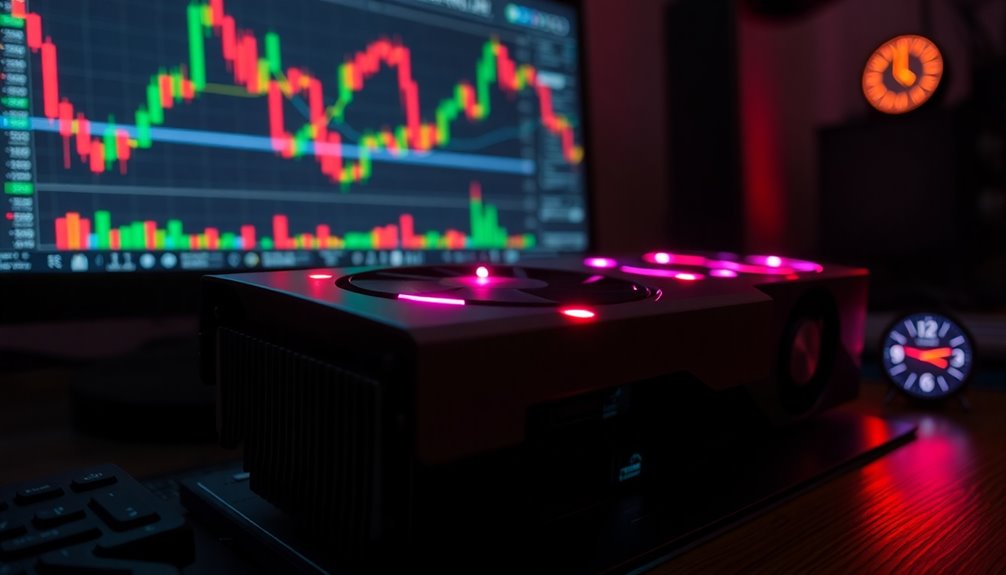
Market volatility plays a crucial role in determining the profitability of your mining operations. Cryptocurrency prices can fluctuate dramatically, impacting your bottom line significantly.
When prices soar, mining becomes profitable, but a mere 10% drop in Bitcoin's value can turn your setup into a loss-maker. High prices also increase GPU demand, leading to market shortages and inflated costs. Conversely, falling prices reduce GPU demand, affecting your operational decisions. Additionally, mining difficulty can complicate matters; events like Bitcoin halving lower rewards, necessitating higher market prices for profitability.
To maintain your margins, you'll need to consider electricity costs and optimize your setup, as these factors can greatly influence your net earnings in this volatile market. Moreover, the anticipated growth of AI datacenters is expected to drive demand for GPU resources, further influencing the market dynamics.
Emerging Mining Software Solutions
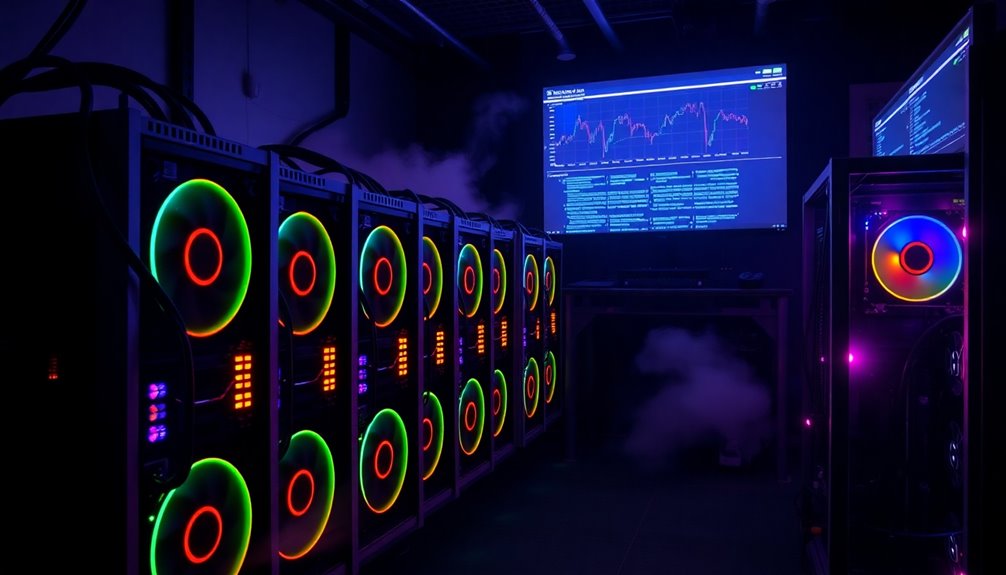
As the cryptocurrency landscape evolves, new mining software solutions are emerging to simplify the process for miners at all levels. User-friendly interfaces like Multiminer and EasyMiner make it easy for you to manage your operations without needing coding skills.
Multiminer detects your hardware and allows you to choose mining strategies, while EasyMiner provides real-time statistics and visual dashboards. Additionally, the growing trend towards user-friendly interfaces ensures that even beginners can navigate complex mining processes with ease.
Cross-platform compatibility is another feature to consider. CGMiner and BFGMiner work on multiple operating systems, ensuring you can mine regardless of your setup.
Advanced features like overclocking and remote monitoring in CGMiner and BFGMiner let you customize your mining experience. With support for various hardware types, these solutions cater to both novices and seasoned miners, enhancing your mining potential.
Optimize Your Power Consumption

Mining software solutions have made it easier to manage your operations, but optimizing your power consumption is just as important for maximizing profitability. Start by adjusting your GPU clock speeds with tools like MSI AFTERBURNER. You can boost an RTX 3060's clock speed from 1320 MHz to 1777 MHz for better performance, but keep an eye on power and temperature. Set a power limit to save 3.0%–31.5% on energy without sacrificing too much performance. Combine overclocking with undervolting to maintain efficiency, cutting power consumption by around 30%. Additionally, the energy-intensive nature of mining means that implementing these optimizations is crucial for sustainability. Use efficiency overclocks to maximize performance per watt. Finally, ensure your power supply has at least a 95% efficiency rating to minimize energy waste and enhance your mining rig's longevity.
Frequently Asked Questions
Is GPU Mining Still Profitable in 2023?
In 2023, GPU mining's profitability can still be viable, but it heavily depends on several factors.
You'll need to consider cryptocurrency prices, mining difficulty, and your electricity costs. If you're using efficient hardware with low power consumption, your chances of earning more increase.
Keep an eye on market fluctuations and competition as they can significantly impact your returns. Balancing these elements will help you determine if it's worth pursuing.
What Cryptocurrencies Can Be Mined With GPUS?
If you're looking to mine cryptocurrencies with GPUs, you've got some great options.
Coins like Monero and Ravencoin are popular choices due to their efficient algorithms and lower competition.
Dogecoin is also a solid pick, especially for beginners.
Bitcoin can be mined, but it's less competitive with ASICs.
Make sure to consider factors like profitability and energy consumption to find the best fit for your mining setup.
Happy mining!
How to Choose the Right GPU for Mining?
Choosing the right GPU for mining involves considering several key factors.
First, look at the hash rate—higher is better for solving puzzles quickly. You'll also want to check the power consumption to ensure efficiency.
Don't forget about VRAM; some cryptocurrencies require specific amounts.
Lastly, consider the GPU model's reputation in the mining community for reliability and profitability.
Balancing these aspects will help you make the best choice for your mining setup.
Are There Legal Issues With GPU Mining?
Yes, there are legal issues with GPU mining that you need to consider.
Regulations vary by state, with some imposing limits on energy use and requiring permits. You'll also have to comply with local environmental laws and ensure your operation doesn't negatively impact the community.
Additionally, transparency is essential, as seen in legal cases involving companies like NVIDIA, where disclosure of sales related to mining is under scrutiny.
Stay informed to navigate these complexities.
How Does Cooling Affect GPU Mining Performance?
Cooling plays a crucial role in your GPU mining performance. It prevents overheating, allowing your GPUs to operate efficiently and maintain optimal performance.
With effective cooling, you can extend the lifespan of your hardware and reduce energy costs. By monitoring temperatures and using the right cooling methods, you'll enhance your mining efficiency and minimize downtime.
Regular maintenance, like cleaning and checking thermal paste, ensures your rig runs smoothly and lasts longer.
Conclusion
In the world of GPU mining, the possibilities are thrilling yet unpredictable. As you dive into this digital frontier, you'll discover both the rewards and pitfalls that come with it. Will you harness the power of graphics processors to turn a profit, or will market volatility leave you in the dust? As new software solutions emerge and optimization techniques evolve, your journey's just beginning. Stay tuned, because the next big breakthrough could be right around the corner.

